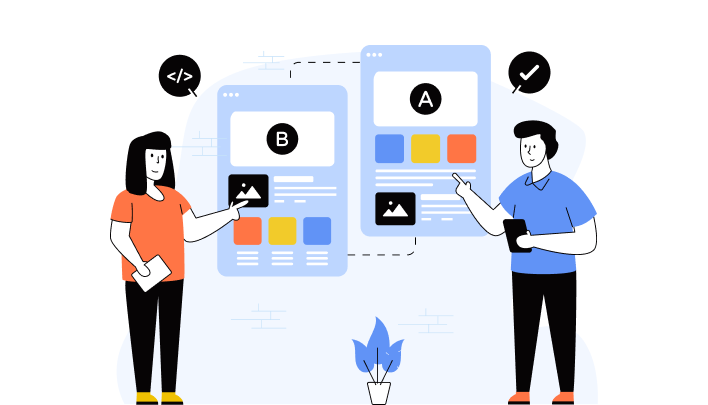Fundamental Approach to UX Research Processes
November 20, 2023 | Read Time : 3 mins
Table of Contents
Approaches to UX Research encompass a diverse range of structured methods and techniques used to gain valuable insights into how users interact with digital products and services. These research approaches are essential for designers, researchers, and organizations as they help uncover user behaviors, preferences, and challenges. The resulting insights lead to the development of user-centered solutions. This introduction offers a gateway to explore the various methodologies and strategies employed in UX research, which can be categorized into quantitative and qualitative approaches. These approaches provide distinct perspectives on the user’s journey and interactions with the digital landscape.
Quantitative research deals with numbers, like data from surveys and analytics, to provide statistical insights into user behavior. It’s great for large-scale data and measuring design impacts.
On the flip side, qualitative research, through methods like interviews and testing, dives into the ‘why’ behind user actions, offering rich insights into thoughts and emotions. It’s crucial for nuanced design decisions.
Need for UX Research
UX research plays a pivotal role in the design and development process by identifying user needs, preferences, and pain points. This understanding leads to user-centered solutions that not only meet user expectations but also reduce the risk of investing in products that may not resonate with the target audience.
Moreover, by addressing usability issues early, it results in cost savings and greater efficiency. UX research is an ongoing, iterative process that drives innovation, supports data-driven design decisions, and keeps products and services in tune with evolving user needs and market demands, ultimately leading to a more successful and user-friendly offering.

UX research also serves as a bridge between user feedback and concrete design decisions. It provides valuable insights that inform the creative process, guiding designers, developers, and stakeholders to make informed choices. This ensures that the final product not only meets user expectations but also aligns with the broader business goals and objectives, fostering a harmonious balance between user satisfaction and organizational success.
UX Research Process
The UX research process adheres to a structured and iterative approach. It all begins with setting clear objectives, pinpointing the target audience, and choosing the appropriate research methods. Researchers then proceed to conduct research sessions, analyze the gathered data, and distill valuable insights that guide design improvements. This is followed by testing and further refinements, all aimed at ensuring a product that remains user-centered. The crucial role of documentation and knowledge preservation cannot be understated.
Here are the essential steps in the UX research process:
- Define Objectives and Goals: Commence by gaining a comprehensive understanding of the project’s objectives. Clearly outline the desired outcomes and goals you aim to achieve through UX research. Articulate the specific questions that need answers and the problems targeted for resolution. Establishing a precise set of objectives sets the groundwork for the entire research endeavor.
- Identify Your Target Audience: Delve into a nuanced exploration of your target audience. Develop comprehensive user personas or profiles extending beyond mere demographics. Seek profound insights into their behaviors, needs, and goals. This in-depth comprehension enables the tailoring of research to the specific characteristics and preferences of your users.
- Choose Research Methods: In the selection of research methods, meticulous consideration is paramount. Align your choices with the research goals and project nature. Common methods include surveys, interviews, usability testing, card sorting, and more. Each method carries its own merits and limitations, necessitating a judicious selection to ensure a thorough and well-rounded approach.
- Plan and Design the Research: Craft an exhaustive research plan, functioning as a detailed roadmap for the entire process. Clearly outline research objectives, methodology, participant recruitment strategy, and a feasible timeline. A well-designed plan assures focus and comprehensive preparedness for a successful execution.
- Recruit Participants: Identify participants embodying the characteristics of your target audience. The number of participants should correspond to the research goals and project scope. Ensure diversity to encapsulate a spectrum of perspectives, considering factors such as age, gender, and user expertise.
- Collect Data: Execute the research plan meticulously, whether through interviews, surveys, observations, or usability tests. Adhere to the plan to systematically gather data, paying meticulous attention to details and unexpected insights.
- Analyze Data: Conduct a meticulous organization and analysis of the amassed data. Employ both qualitative and quantitative analysis methods. Discern patterns, trends, and insights that illuminate user experiences and preferences.
- Generate Findings and Insights: Compile the research findings into a coherent set of insights. Identify key takeaways and illuminate user pain points and areas of opportunity. This phase serves as the crucial link between raw data and actionable recommendations.
- Create Personas and User Journey Maps: Leverage gained insights to craft detailed user personas and user journey maps. These visual tools encapsulate the characteristics, behaviors, and experiences of your users, providing a holistic perspective that informs informed design decisions.
- Share Results: Effectively communicate research findings and insights to the project team, stakeholders, and decision-makers. Utilize visualizations such as charts, graphs, and storytelling to facilitate the assimilation of information. This step is pivotal for garnering support and alignment among key stakeholders.
- Make Recommendations: Translate research into actionable recommendations for design enhancements. Ensure that recommendations directly address identified issues and opportunities. Provide clear and concise guidance for subsequent steps in the design process.

- Iterate and Test: Collaborate with design and development teams to implement changes based on recommendations. Engage in a continual cycle of testing and refinement through usability testing and user feedback. Iterative improvements ensure the evolution of design to effectively meet user needs.
- Monitor and Evaluate: Post-implementation, persist in monitoring and evaluating the user experience. Assure the effectiveness of implemented changes in alignment with user needs. Be prepared to make further adjustments based on ongoing feedback and observations.
- Document and Share: Thoroughly document the entire research process, including methods employed, findings, and recommendations. Share this documentation with the team and stakeholders for future reference. A well-documented process contributes to knowledge retention and supports future decision-making.
- Continuous Improvement: Acknowledge UX research as an ongoing, iterative process. Establish mechanisms for continuously gathering feedback and data to refine and enhance the user experience over time. Embrace a mindset of continuous improvement, ensuring your product remains attuned to evolving user expectations and industry trends.
Seek User Feedback Post-Launch
Ensuring an avenue for user feedback post-launch is pivotal for the prolonged success of the product. The insights gleaned from real-world user experiences offer a nuanced perspective on the efficacy of implemented changes. Embrace this feedback loop as a valuable tool for ongoing enhancement, enabling your team to address unforeseen challenges and seize additional opportunities for refinement. It underscores the dynamic nature of user experience, emphasizing the need for perpetual adaptability.
By recognizing that UX is an ever-evolving process, you position your team to stay responsive to emerging trends, evolving technologies, and the ever-changing landscape of user expectations. This commitment to continuous improvement ensures that your product not only meets but anticipates the evolving needs of its users, fostering a resilient and user-centric design ethos. So, keep those insights flowing and let’s make this product even better together!






